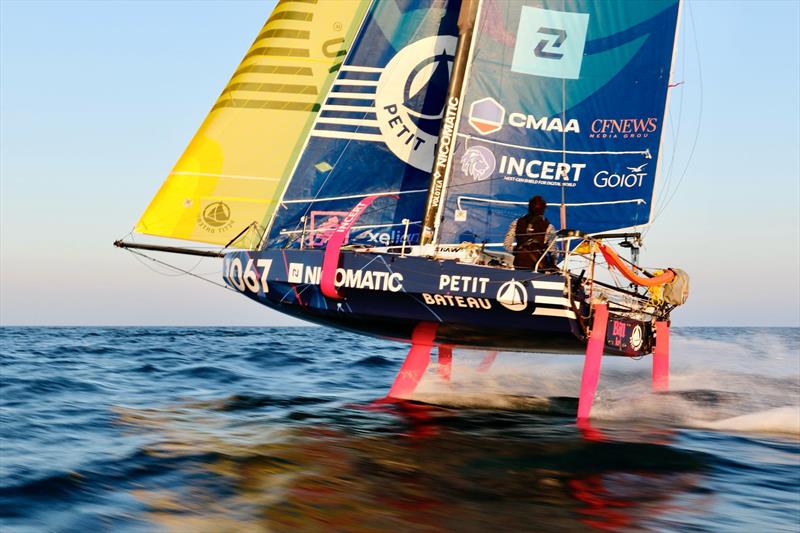
Meet Benoit Marie: 6-for-6 and Mini Transat Ready
by Cyclops Marine 20 Sep 11:00 UTC

Benoit Marie's Mini Nicomatic x Petit Bateau © Sam Cade
Benoit Marie isn't just having a good season — he's having a perfect one onboard his Classe Mini Nicomatic x Petit Bateau. Six races. Six wins.
Now, with just a 7,500 km solo mission across the Atlantic Ocean between him and perfection, we caught up with Benoit ahead of the Mini Transat to learn more about him, and the data that's helping him along the way.
Benoit has had other stand-out years on the Mini Circuit. In 2013, as an amateur, he won the Mini Transat in a huge upset.
"It was my very first transatlantic race! This victory marked a turning point in my life and propelled me into the world of professional skippers."
A sailor, designer and engineer with a passion for innovation, Benoit founded SKAW Sailing, which develops cutting edge projects. His Mini Nicomatic x Petit Bateau, co-designed with Sam Manuard, is one of its flagship ventures.
"I specialise in foiling boats and have become a true flying expert. I sailed on various boats such as the International Moth (double French champion, 7th in the world in 2018), the Class A (French champion 2019), the Class C (vice-world champion in 2015), and the ETF26, which I helmed for JP Dick aboard ABC Arbitrage, with a first and second place on the circuit in 2018 and 2019."
Fast forward to 2025, and he's back in the Mini. Currently leading the way by some distance in the 2025 Classe Mini standings, this time it would be no surprise if he came out on top. As he tells Cyclops, "something has really clicked."
Actually, that's an understatement. But figuring out what's clicked isn't always the easiest thing to do. When you're equipped with empirical numbers from wireless load sensors - both live and logged for analysis - it becomes that bit easier, and Benoit credits his new Cyclops setup as making a big difference:
"On a boat like my foiling Mini, the loads on every part are tripled compared to non-foiling designs," he explains.
"We had to triple the mainsheet purchase and reinforce everything—sails, structure, rigging. The physics is simple: load increases with the square of speed...
We've clocked 31.9 kts... conventional boats hardly ever reach 20 kts. So it is clearly a huge step in terms of performance."
But all that extra power comes with added risk—pushing it to the limit means there's a much higher chance of breaking something.
"In the first two Transats featuring the Pogo foiler, key parts failed—bowsprits, forestay attachments... serious stuff. We knew we had to think around that."
"So, we sailed a lot, pushed as hard as possible, breaking parts of the boat one after the other, and started to monitor the actual loads thanks to Cyclops sensors in various locations on the standing and running rigging."
"Now we can push hard, right to the limits - with 100% faith in the reliability of the boat - ensuring our Mini can keep its huge foiling potential all the way across the Atlantic Ocean."
"Cyclops is also a huge help at night. It's like having a headlight, because, without being able to see the rig and sails, you can see where your set up is by looking at the numbers. It doesn't do all the job but it helps to prevent mistakes by showing you the important traps on the way."
"I am really happy that we managed to put numbers on feelings. It's really helped us take the campaign to a new level."
Eye on the Prize
The Mini Transat is in his sights, and Benoit is engineered to perform. With six wins behind him, a fully tuned foiling machine beneath him, and Cyclops data driving decisions, he's ready.
Fast, repeatable settings aren't just for ocean racers. Weekend sailors all over the world are supercharging their results with live and logged data from Cyclops sensors.
Visit the Cyclops website or speak to an expert to find the sensor for your boat.